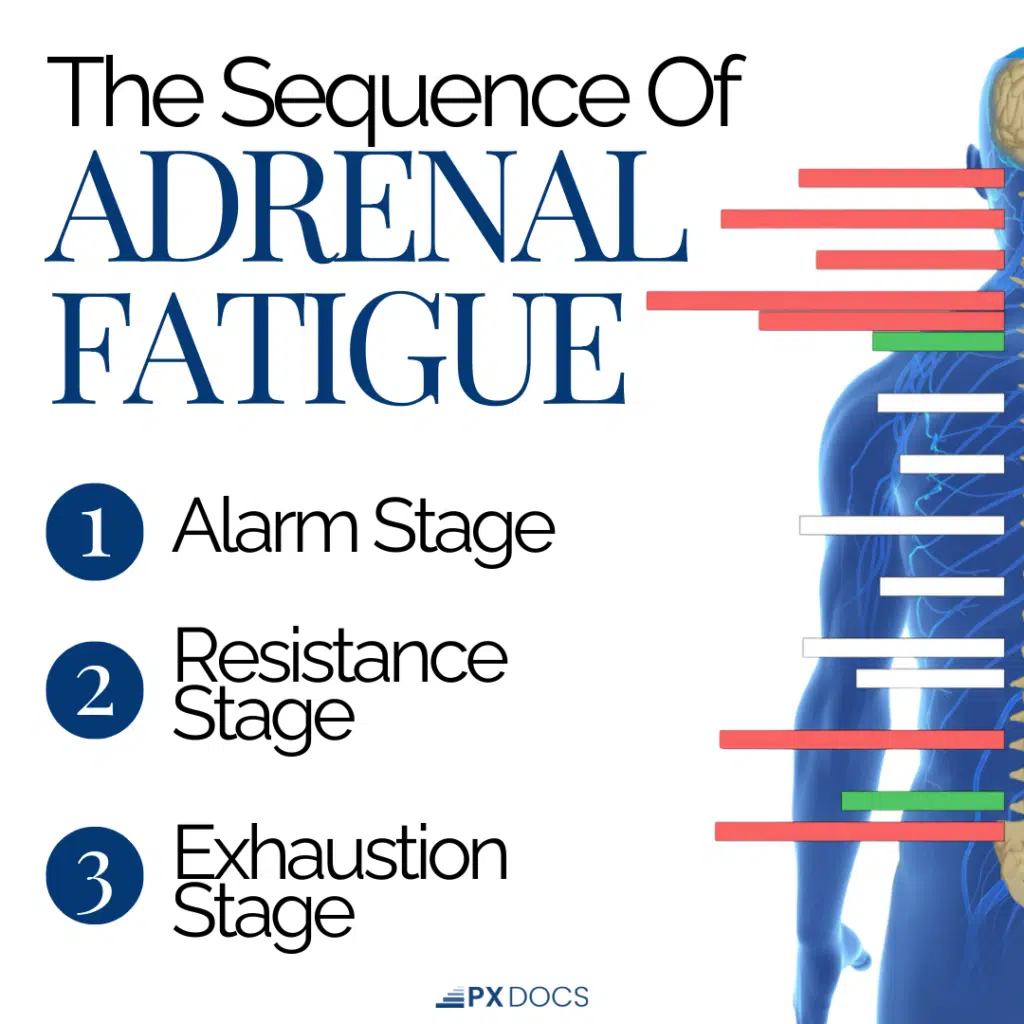Are you a parent who feels constantly exhausted and overwhelmed and struggles to keep up with the demands of modern life? If so, you’re not alone. This hidden epidemic is plaguing families across the country, causing extreme exhaustion and robbing them of doing what they love with their friends and family.
Adrenal fatigue is a condition that occurs when the body’s stress response system becomes overworked and unable to keep up with the constant demands placed upon it. Adrenal fatigue can include extreme physical fatigue, difficulty waking up in the morning, brain fog, weakened immune function, and intense cravings for salty or sugary foods.
For parents, adrenal fatigue from an overactive nervous system can be particularly devastating. Trying to care for children while running on empty can feel like an impossible task. Many parents report feeling like they’ve lost their spark and are just going through the motions of daily life.
But what if there was a way to reclaim your energy and drive for life? As PX Docs, we specialize in helping families overcome adrenal fatigue using a unique, neurologically-focused approach that addresses the root cause of the problem. By supporting the nervous system and restoring balance to the body, we’ve helped countless parents go from surviving to thriving.
What is Adrenal Fatigue?
To fully grasp the impact of adrenal fatigue, it’s essential to understand the critical role of the adrenal glands in the body. The adrenal glands are small, triangular-shaped glands that sit on top of the kidneys. They produce a variety of hormones, including cortisol, adrenaline, and aldosterone, which help regulate everything from blood sugar and inflammation to stress response and blood pressure.
When the body is under chronic stress, the adrenal glands can become overworked and unable to keep up with the constant demand for cortisol production. This can lead to a condition known as adrenal fatigue, where the glands can no longer produce sufficient amounts of cortisol and other hormones.
Adrenal fatigue typically progresses through three distinct stages:
- Alarm stage: The body’s initial response to stress, characterized by elevated cortisol levels and a heightened fight-or-flight response
- Resistance stage: As stress continues, the body adapts and tries to maintain balance, but cortisol levels may start to dip, leading to fatigue and mood changes.
- Exhaustion stage: When stress becomes chronic, and the adrenals can no longer keep up, cortisol levels drop significantly, and symptoms intensify.

Common traits of adrenal fatigue include:
- Extreme fatigue, particularly upon waking
- Difficulty falling asleep or staying asleep
- Brain fog and difficulty concentrating
- Weakened immune function and frequent illness
- Intense cravings for salty or sugary foods
- Weight gain or weight loss
- Mood changes, such as irritability, anxiety, or depression
- Dizziness or lightheadedness upon standing
- Digestive issues, such as bloating or constipation
Why this Matters for Teens and Adults
For parents, the symptoms of adrenal fatigue can be particularly challenging. Trying to keep up with the demands of parenting while running on empty can feel like an uphill battle. Many parents with adrenal fatigue report feeling like they’ve lost their patience, energy, and ability to cope with the daily stresses of family life. The accumulated impact of years of stress can lead to symptoms that seem hard to recover from, such as brain fog, poor sleep, and low energy—all signs of potential adrenal fatigue.
And for our poor teenagers, who already face high demands from growth, hormones, school, sports, activities, and peer-pressure, a constant stress cycle can quickly drain their energy and leave them feeling rundown.
What Causes Adrenal Fatigue?
Adrenal fatigue is rarely the result of a single stressor or event. Instead, it often develops due to a combination of factors that accumulate over time and cause chronic stress and exhaustion, which can wear down our body’s stress management systems.
As PX Docs, we group stress into three main sources: physical, chemical, and emotional.
- Physical stressors include things like lack of sleep, over-exercising, and injuries or illnesses that demand extra energy and healing.
- Chemical stressors often involve diet, such as poor nutrition, excessive sugar or caffeine, and even exposure to environmental toxins or medications/interventions, which put additional strain on the body’s nervous system.
- Emotional stressors are perhaps the most noticeable in teens and adults. Relationship difficulties, social pressures, school or work demands, financial concerns, and even the endless stream of digital information can all elevate emotional stress.
When these stressors persist, it creates dysregulation within the nervous system and other parts of the body that control the hormonal outputs from the adrenals. Once the sympathetic nervous system is activated, it immediately in turn activates the adrenal glands. However, when this sympathetic overdrive becomes chronic and sustained, the adrenals simply can’t keep up and fatigue and depletion begin to set in.
One of the “stress-response circuits” in the body that directly correlates with adrenal fatigue is the HPA axis(Hypothalamus-Pituitary-Adrenal), which starts in the brain and controls the adrenal glands and hormones. Here’s a breakdown of how these systems interact and what happens when they’re under constant pressure.
1. The HPA Axis – The Stress Response Circuit
When we experience stress (whether physical, chemical, or emotional), the brain’s hypothalamus (H) signals the pituitary gland (P), which then tells the adrenal glands (A) to release stress hormones like cortisol. Cortisol helps us respond to stress by keeping us alert, boosting our energy, and preparing our bodies to handle whatever is happening. It is an intelligently designed system, and we need it in order to survive. But if the stress is stuck on and continues non-stop, think school pressures, work stress, social conflicts, or even daily worries, the HPA axis stays “switched on.” This can keep cortisol levels high for prolonged periods.
2. HPA Axis Burnout and the Adrenals
When the HPA axis is stuck in “stress mode,” the adrenal glands get exhausted from producing cortisol around the clock. Over time, they can’t keep up with the demand, leading to low cortisol levels. This is the state often referred to as “adrenal fatigue.” Low cortisol makes it harder for the body to manage even everyday stress, causing fatigue, irritability, weakened immunity, and brain fog.
The Nervous System’s Foundational Role in Adrenal Health
Hormones and pathways like the HPA axis always steal the show in conventional and functional medicine. Many doctors run to medication, stool analysis, or blood panels. And yes, hormonal regulation is a huge problem that needs to be addressed BUT it is not the root cause of adrenal fatigue. So what is?
To truly understand adrenal fatigue and find lasting solutions, we must look beyond the adrenal glands themselves and examine the nervous system’s critical role in regulating adrenal function.
The autonomic nervous system (ANS) is the body’s master control system, which regulates involuntary functions such as heart rate, digestion, and hormone production. It is divided into two branches: the sympathetic nervous system (SNS), which activates the “fight or flight” response during times of stress, and the parasympathetic nervous system (PNS), which promotes “rest and digest” functions and helps the body recover from stress.
If the brain and body aren’t correctly adapting to chronic stress, the fight or flight side of the nervous system will constantly stay activated, which can lead to more nervous system dysregulation. This imbalance can lead to HPA axis dysregulation and burnout in other systems as well, such as the HPG axis (which impacts reproductive hormones like estrogen and testosterone). When stress is stuck on, the nervous system loses the ability to bounce back into the “rest, digest, and regulate” state, exhausting both mental and physical energy reserves, making it hard to have the energy for all of the things we enjoy!
The Vagus Nerve
One of the key players in the nervous system is the vagus nerve, a long, wandering nerve that extends from the brainstem to the abdomen. When functioning correctly, the vagus nerve helps to counterbalance the effects of the sympathetic nervous system, promoting relaxation and recovery.
However, when the nervous system is out of balance, it can contribute to the development of adrenal fatigue. Two of the most common imbalances impacting adrenal function are subluxation and dysautonomia.
Subluxation refers to interference and dysfunction within the neurospinal system that can interfere with proper nervous system regulation. When subluxations occur, they can disrupt the function of the vagus nerve and other vital components of the autonomic nervous system. This can lead to an overactive sympathetic and underactive parasympathetic responses, setting the stage for adrenal fatigue.
Dysautonomia, however, refers to a broader imbalance in the autonomic nervous system. When the sympathetic and parasympathetic branches are not working in harmony, it can lead to a wide range of issues, including those associated with adrenal fatigue.
Limitations of Conventional Medical Approaches
One of the primary limitations of conventional approaches is focusing on symptom management rather than addressing the root cause of adrenal fatigue. Patients may be prescribed stimulants, such as caffeine or prescription medications, to help combat fatigue, but these solutions only provide temporary relief and can further deplete the adrenal glands over time.
Additionally, conventional medicine often relies heavily on pharmaceuticals, such as antidepressants or sleep aids, to address the mood and sleep disturbances associated with adrenal fatigue. While these medications can provide some relief, they do not address the underlying nervous system imbalances contributing to overall dysfunction.
Another limitation of conventional approaches is the lack of recognition of adrenal fatigue as a legitimate diagnosis. Many traditional healthcare providers may not be familiar with the concept of adrenal fatigue or may dismiss it as a “pseudoscience.” This can leave patients feeling frustrated, unheard, and without a clear path forward.
Neurologically-Focused Chiropractic Care
At PX Docs, we take a unique approach to addressing adrenal fatigue by focusing on the nervous system. Our Neurologically-Focused Chiropractic Care is designed to identify and correct subluxations and nervous system imbalances that can contribute to adrenal dysfunction.
The first step in our approach is to perform a comprehensive neurological assessment using our cutting-edge INSiGHT scanning technology. This non-invasive tool allows us to measure the function of the autonomic nervous system and pinpoint areas of subluxation and dysautonomia.
In this EMG scan, we can see the classic signs of sympathetic overdrive and adrenal fatigue. The green, blue, and red in the neck and shoulders region is a classic stress and tension response, where patients feel stressed out or “wound up” all the time, often feeling it as physical tension in those regions along with difficulty sleeping and emotional dysregulation. Then the smaller, yellow bars in the lower regions indicate adrenal fatigue and hypoactivity, which correlates with the “worn out” presentation so many patients present with today.
This shows us that the nervous system and HPA axis have chronically been stuck in fight or flight and the body is now running out of gas. This leads to adrenal fatigue in adults and teens.
Armed with this objective data from the EMG scan and two other scans, Heart Rate Variability and NeuroThermal, our doctors will create a personalized care plan to address the neurological imbalances contributing to adrenal fatigue. This may include gentle, precise chiropractic adjustments to correct subluxations to stimulate the vagus nerve and promote parasympathetic function.
If you or your teenager are constantly feeling “wound up and worn out” at the same time, you must get into a PX Docs office to have these INSiGHT Scans run and get to the real root cause of your adrenal fatigue and nervous system dysregulation.
How to Fix Adrenal Fatigue: Lifestyle Modifications
In addition to Neurologically-Focused Chiropractic Care, several lifestyle modifications can support adrenal recovery and promote long-term health and resilience. At PX Docs, we work closely with our patients to develop personalized lifestyle plans that address their unique needs and challenges after their nervous system is strong, resilient, and regulated.
Some of the critical lifestyle modifications we recommend for adrenal fatigue include:
- Nutrition: Eating a balanced, whole-food diet that stabilizes blood sugar and provides vital nutrients for adrenal health, such as vitamin C, B vitamins, magnesium, and herbs like ashwagandha.
- Sleep: Prioritizing consistent, restorative sleep by creating a calming bedtime routine, avoiding electronic devices before bed, and aiming for 7-9 hours of sleep per night.
- Stress management: Incorporating stress-reducing practices like meditation, deep breathing, gentle exercise, and time in nature, and learning to set healthy boundaries.
- Fitness: Finding the right amount and type of physical activity, likely mixing various elements such as walking, cardio, strength training, yoga and so forth helps restore proper stimulation to the brain and nervous system and regulate energy levels.
- Mindset: Cultivating a positive, growth-oriented mindset, practicing self-compassion, challenging perfectionism, and embracing a more balanced approach to life.
By combining Neurologically-Focused Chiropractic Care with supportive lifestyle modifications, our patients can achieve lasting improvements in their adrenal health and overall well-being.
Adrenal Fatigue Ends Here
If you are burnt out, struggling with exhaustion, and other symptoms of adrenal fatigue, know that you’re not alone—and that there is hope. By understanding the root causes of adrenal dysfunction and embracing a neurologically-focused approach to care, it is possible to reclaim your energy and love for life.
If you’re ready to take the first step on your journey to adrenal health, we invite you to visit our PX Docs Directory and find a qualified practitioner near you. With the proper care and support, you can reclaim your vitality and start living the life you deserve.






